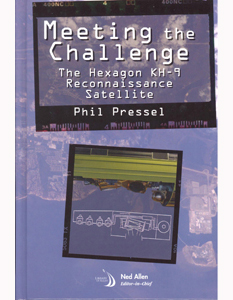Hexagon was America’s last film-based photoreconnaissance satellite, developed in the 1960s and ‘70s and not declassified until 2011. The author, however, made the decision to write this book in 2004 and set about obtaining permission from the CIA to publish it and, effectively, to get the Hexagon programme declassified. He writes of the difficulty in getting people to remember what they did in a programme without recourse to technical records, let alone persuading them to write it down: “Trying to get started to fill up an empty page was very hard”, he says. Nevertheless, he succeeded and this book is both a record of a fascinating space programme and a tribute to the people at the Perkin Elmer Corporation who worked on it (Appendix F even includes a list of names by department).
From the start, the author grabs the reader’s attention with a quote from Perkin Elmer’s CEO at the end of the final pitch to the customer, the CIA. He “put his foot up on the table and said ‘We want this f____g job and we’re gonna get every f____g agency and every f____g engineer from here to Florida. We recognize the importance to national security and we’re capable of doing the job.’” It’s not clear how his style would go down in a presentation today, but it didn’t stop Perkin Elmer getting the contract a few months later.
In 19 chapters and six appendices by various authors involved personally in the Hexagon programme, the book provides details of the development of the technology and the operational and mission aspects. Chapter headings give an early indication of the level of detail – e.g. “Looper, Film Path, Pneumatics and Thermal Design” and “Platen and Film Drive” - but line drawings and good descriptions make this less of a trial than it might appear. Other chapters, such as “Joining the Corporation” and “Film and a Disagreement with the CIA” offer breaks from the nuts and bolts.
Overall, this is an extremely accessible presentation of what could be a very dry subject, which is largely thanks to the writing style of the author who “wrote the book as a labor of love” (which is never a bad reason). In fact, as if writing a history book wasn’t challenging enough, he had to take unusual measures to protect sensitive information before it had been cleared by the CIA. He reveals “First, I had a safe bolted to the floor of my bedroom closet in which I kept all the documents. Most importantly, I obtained a laptop computer that was totally and exclusively dedicated to writing this book, and I added an encryption program. I never connected this laptop to the Internet, so hacking was never an issue.” I venture to suggest that if all authors were presented with this as a list of prerequisites, there would be a lot less shelf-space required in libraries!
Mark Williamson, Space Technology Consultant











